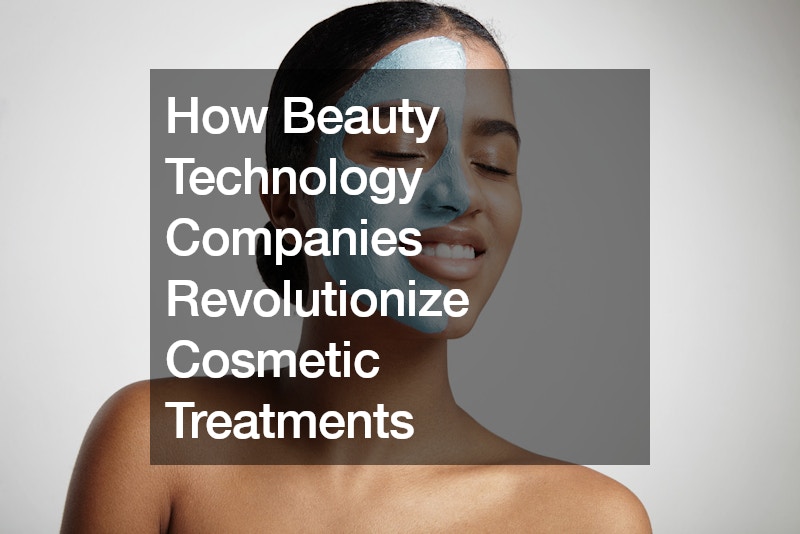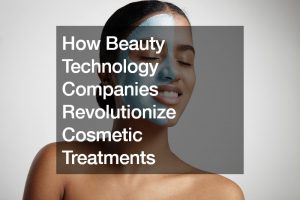In recent years, beauty technology companies have redefined the landscape of cosmetic treatments, merging cutting-edge technology with aesthetic practices to deliver unprecedented results. As these companies introduce innovative tools and techniques, they not only enhance the effectiveness of treatments but also improve safety and patient satisfaction. This blog explores how these advancements are making waves across various domains of cosmetic treatments, from the precision work of plastic surgeons to the delicate processes involved in laser tattoo removal.
Innovating with Plastic Surgeons: Shaping the Future of Cosmetic Surgery
Beauty technology companies are playing a pivotal role in transforming the field of cosmetic surgery, particularly through their collaborations with plastic surgeons. By integrating advanced imaging tools and robotic assistance, these companies enhance the precision of surgical procedures, enabling surgeons to achieve more accurate and aesthetically pleasing outcomes. This synergy not only elevates the standards of safety and efficiency but also expands the possibilities of what can be achieved in cosmetic surgery.
The partnership between beauty technology companies and plastic surgeons has led to significant advancements in procedures such as facelifts and rhinoplasties. For instance, 3D modeling software allows surgeons to plan and predict outcomes with greater accuracy before making a single incision, thus reducing the risk of postoperative complications and ensuring patient expectations are met more consistently. This level of precision underscores the transformative impact that technology has on the art and science of plastic surgery.

Advances in Laser Tattoo Removal: A Cleaner Slate
The continued enhancement of laser tattoo removal technologies by beauty technology companies has marked a new era in cosmetic treatments. These companies are pioneering the development of lasers that can more efficiently break down ink particles with minimal risk to the surrounding skin. This progress not only increases the efficacy of tattoo removal but also reduces the pain and recovery time associated with the procedure. As a result, patients can expect cleaner and more effective removal, making it easier to erase unwanted tattoos and clear the canvas of their skin.
Specifically, the introduction of multi-wavelength laser systems by beauty technology companies has revolutionized tattoo removal. These systems are designed to target different ink colors at varying depths, which effectively removes tattoos with a broader range of pigments and complexities. This advancement not only caters to a larger demographic but also ensures that removal is more complete and scars are minimized. The ability to tailor the treatment to individual needs and tattoo specifics exemplifies how technology is enhancing patient-specific outcomes in cosmetic procedures.
New Frontiers in Skin Tightening Treatments
Beauty technology companies are at the forefront of redefining skin tightening treatments, introducing non-invasive methods that offer patients significant results without the downtime associated with traditional surgery. Innovations such as radiofrequency (RF) and ultrasound technology are now widely used to stimulate collagen production, firming and tightening the skin from within. This shift not only provides a safer alternative to surgical options but also opens the door to more people seeking cosmetic enhancements with less interruption to their daily lives.
On a more specific note, the development of micro-focused ultrasound with visualization (MFU-V) technology by beauty technology companies has set new standards in skin tightening treatments. This technology allows practitioners to see the layers of tissue being targeted during the treatment, ensuring energy is delivered precisely where it is most beneficial. The precision of MFU-V not only maximizes the effectiveness of each session but also enhances the overall safety of the procedure, pushing the boundaries of what non-surgical skin tightening can achieve.

Revolutionizing Professional Medical Billing in Cosmetics
The integration of advanced software solutions by beauty technology companies has significantly streamlined professional medical billing processes in the cosmetic industry. These technological enhancements automate many of the cumbersome tasks associated with billing and insurance claims, reducing errors and improving efficiency. This shift not only benefits the providers by freeing up more time to focus on patient care but also enhances the patient experience by simplifying the financial aspects of cosmetic treatments.
In more specific terms, beauty technology companies have introduced cloud-based billing systems that enable real-time updates and access from multiple locations. This technology allows cosmetic clinics to manage billing more effectively, ensuring that claims are processed quickly and accurately. By minimizing the administrative load and improving accuracy, these systems help clinics reduce overhead costs and improve their bottom line, demonstrating how technology can impact both the operational and clinical aspects of cosmetic practices.
Emerging Technologies in Med Spa Services
Beauty technology companies are reshaping the landscape of med spa services by introducing a range of emerging technologies that enhance treatment options and outcomes. From laser skin rejuvenation to advanced body contouring systems, these innovations provide med spas with the tools to offer more personalized and effective treatments. The use of these advanced technologies not only attracts a broader clientele but also sets new standards in the quality and variety of non-surgical aesthetic procedures available.
Drilling down into specifics, the adoption of AI-driven analysis systems in med spa services, facilitated by beauty technology companies, has optimized treatment plans and outcomes. These systems analyze patient data to recommend the most effective treatments tailored to individual skin types and cosmetic goals. This personalized approach not only improves patient satisfaction but also enhances treatment efficacy, showcasing how beauty technology companies are instrumental in driving forward the capabilities of med spa services.

Transformative Impacts of Morpheus8 on Skin Rejuvenation
Beauty technology companies have significantly advanced the field of skin rejuvenation with the introduction of Morpheus8, a device that combines microneedling with radiofrequency (RF) energy to achieve profound subdermal remodeling. This innovation allows for the precise targeting of deeper layers of the skin, promoting collagen production and tightening at a level previously unachievable with traditional methods. The result is dramatically improved skin texture and firmness, showcasing how technological advancements can enhance cosmetic outcomes.
Morpheus8 specifically benefits from the precision of its technology, which can be adjusted to different depths and intensities, allowing practitioners to customize treatments based on individual skin conditions and goals. This adaptability makes it particularly effective for treating a wide range of issues, from fine lines and wrinkles to acne scars and skin laxity. The ability of beauty technology companies to refine and enhance such technologies underscores their critical role in evolving the standards and capabilities of aesthetic treatments.
Breakthroughs in Medical Grade Adhesive for Skin Applications
The development of medical grade adhesives for skin applications by beauty technology companies is revolutionizing the way treatments are administered and managed in cosmetic medicine. These adhesives are designed to securely attach devices to the skin or close wounds with minimal risk of irritation or infection. The advancements in adhesive technology not only improve the practical application of cosmetic devices but also enhance patient comfort and treatment outcomes, making procedures safer and more efficient.
On a more specific level, these innovative adhesives have enabled the creation of wearable cosmetic devices that can deliver treatment agents or perform light-based therapies directly to the skin. This allows for continuous treatment without the need for frequent clinical visits, providing a convenient and effective option for patients. Such developments highlight how beauty technology companies are not only enhancing existing treatment methods but also creating new possibilities within the cosmetic industry.

Enhancing Patient Research with Innovative Tech Tools
Beauty technology companies are revolutionizing patient research by integrating innovative tech tools that enhance the accuracy and accessibility of information. These tools include advanced databases and AI-driven platforms that provide insights into treatment efficacy and patient outcomes, fostering a deeper understanding of cosmetic procedures. This technology-driven approach not only empowers patients with the knowledge they need to make informed decisions but also helps practitioners refine their techniques and treatment plans based on real-world data.
In a more detailed view, beauty technology companies have developed sophisticated algorithms that analyze vast amounts of data to identify trends and predict treatment outcomes. This allows patients and clinicians to explore different scenarios and outcomes before deciding on a course of action, significantly improving the personalization of cosmetic treatments. These predictive models not only contribute to higher satisfaction rates but also enhance the scientific approach within the aesthetic community, showcasing the profound impact of technology on patient-centered research.
Technology-Driven Approaches to Breast Augmentations
Beauty technology companies are leading the way in transforming breast augmentations through technology-driven approaches that enhance both the planning and execution phases of the procedure. Using 3D imaging and virtual reality, these companies enable patients and surgeons to visualize potential outcomes before surgery, increasing confidence in the expected results. This approach not only improves patient satisfaction but also assists surgeons in achieving more precise and symmetrical outcomes, ultimately enhancing the aesthetic results of breast augmentations.
Specifically, the use of 3D sizers and simulation software allows patients to see their post-surgery bodies from various angles, providing a realistic preview of how their new figure will look. This technology ensures that patients have realistic expectations and are more satisfied with the outcome. Furthermore, it aids surgeons in selecting the appropriate implant size and shape that best fits the patient’s body type and desired look, further illustrating how beauty technology companies are crucial in advancing the field of cosmetic surgery.
Integrating Technology in Hormone Therapy Clinics
Beauty technology companies are also making significant inroads in hormone therapy clinics by integrating sophisticated technology that enhances treatment precision and patient monitoring. This includes the development of advanced diagnostic tools that provide accurate hormone level assessments and personalized treatment plans. These technological advancements ensure that patients receive the most effective and tailored hormone therapy, improving overall health outcomes and patient satisfaction in the process.
Further refining this approach, beauty technology companies have introduced wearable devices that continuously monitor hormone levels, providing real-time data to healthcare providers. This allows for immediate adjustments to treatment protocols based on dynamic changes in a patient’s condition, ensuring optimal therapy at all times. Such innovations not only enhance the efficacy of hormone treatments but also demonstrate how technology can profoundly influence patient care in specialized medical fields.
Preventing Negative Patient Outcomes From Cosmetic Treatments
As beauty technology companies advance the field of cosmetic treatments, a significant focus is placed on preventing negative patient outcomes. Through the use of sophisticated analytics and risk assessment tools, these companies can identify potential complications before they occur. This proactive approach ensures that treatments are not only effective but also safe, minimizing risks associated with procedures. Additionally, continuous monitoring and feedback systems allow practitioners to adjust treatments in real-time, further reducing the likelihood of adverse effects.
To be more specific, beauty technology companies have developed software that integrates patient medical histories with predictive analytics to foresee possible side effects or complications related to various cosmetic treatments. This technology enables clinicians to tailor their approaches based on individual risk factors, such as allergies or previous adverse reactions to treatments. Moreover, the introduction of virtual follow-ups and patient education platforms ensures ongoing support and care, enhancing the overall safety and satisfaction of cosmetic procedures. This comprehensive approach by beauty technology companies is pivotal in enhancing patient trust and confidence in cosmetic treatments.
Conclusion
Beauty technology companies are at the forefront of revolutionizing cosmetic treatments, bringing about a new era of precision, safety, and personalization. From enhancing the capabilities of plastic surgeons to innovating med spa services and improving hormone therapy, these companies have utilized cutting-edge technology to transform every aspect of cosmetic care. As they continue to innovate, the future of cosmetic treatments looks promising, with even greater advances on the horizon. This ongoing evolution will undoubtedly continue to enhance patient outcomes, streamline clinical processes, and expand the possibilities within the realm of aesthetic medicine.






